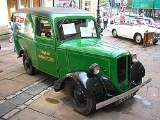
Jowett Bradford
Encyclopedia
The Jowett Bradford was a British light van
, also available as an estate car from 1947, that was produced from 1946 to 1953 by Jowett Cars Ltd
of Idle
, near Bradford
, England.
The vehicle was based on the pre war Jowett Eight and was the first Jowett to be re-introduced after the Second World War
and in spite of being very basic appealed to the post war market because of its economy and availability.
s in which form it sold in large numbers both at home and abroad.
in 1952 had a top speed of 53.4 mph (85.9 km/h) and could accelerate from 0-50 mph (80.5 km/h) in 47.6 seconds. A fuel consumption of 34.5 mpgimp was recorded. The test car cost £740 including taxes. The de-luxe specification had added £38 to the total for which you got trafficators
, dual windscreen wipers, running board
s, a rear bumper and some chromium plating.
Van
A van is a kind of vehicle used for transporting goods or groups of people.In British English usage, it can be either specially designed or based on a saloon or sedan car, the latter type often including derivatives with open backs...
, also available as an estate car from 1947, that was produced from 1946 to 1953 by Jowett Cars Ltd
Jowett
Jowett was a manufacturer of light cars and light commercial vehicles in Bradford, West Yorkshire, England from 1906 to 1954.-Early history:Jowett was founded in 1901 by brothers Benjamin and William Jowett with Arthur V Lamb. They started in the cycle business and went on to make V-twin engines...
of Idle
Idle, West Yorkshire
The village of Idle and its outskirts make up a mainly residential suburban area in the city of Bradford, West Yorkshire, in England. The area is loosely bordered by the areas of Eccleshill, Wrose, Thackley and Greengates, in the north east of the city....
, near Bradford
Bradford
Bradford lies at the heart of the City of Bradford, a metropolitan borough of West Yorkshire, in Northern England. It is situated in the foothills of the Pennines, west of Leeds, and northwest of Wakefield. Bradford became a municipal borough in 1847, and received its charter as a city in 1897...
, England.
The vehicle was based on the pre war Jowett Eight and was the first Jowett to be re-introduced after the Second World War
World War II
World War II, or the Second World War , was a global conflict lasting from 1939 to 1945, involving most of the world's nations—including all of the great powers—eventually forming two opposing military alliances: the Allies and the Axis...
and in spite of being very basic appealed to the post war market because of its economy and availability.
Design features
The chassis featured half elliptic leaf springs front and rear with beam axles and the flat twin cylinder engine produced 19 bhp and drove the rear wheels through a three speed non-synchromesh gearbox. In 1950 the engine was updated to give 25 bhp and synchromesh was fitted to the top ratio. This improved the top speed to 53 mph (85 km/h). The 10 in (254 mm) drum brakes were operated mechanically using a Girling system.Body variants
Initially only a van version was made but in 1947 it was joined by an estate car, the Utility, but this was little more than the van with side windows and rear seats. It was also manufactured in pickup form, and driveaway-chassis and cab-chassis versions were made for outside coachbuilderCoachbuilder
A coachbuilder is a manufacturer of bodies for carriages or automobiles.The trade dates back several centuries. Rippon was active in the time of Queen Elizabeth I, Barker founded in 1710 by an officer in Queen Anne's Guards, Brewster a relative newcomer , formed in 1810. Others in Britain included...
s in which form it sold in large numbers both at home and abroad.
Performance
A Utility de-luxe tested by the British magazine The MotorThe Motor (magazine)
The Motor was a British weekly car magazine founded on 28 January 1903....
in 1952 had a top speed of 53.4 mph (85.9 km/h) and could accelerate from 0-50 mph (80.5 km/h) in 47.6 seconds. A fuel consumption of 34.5 mpgimp was recorded. The test car cost £740 including taxes. The de-luxe specification had added £38 to the total for which you got trafficators
Trafficators
Trafficators are semaphore signals which, when operated, protrude from the bodywork of a motor vehicle to indicate its intention to turn in the direction indicated by the pointing signal. Trafficators are often located at the door pillar.-History:...
, dual windscreen wipers, running board
Running board
A running board is a car or truck accessory part, a narrow step fitted under the side doors of the vehicle. It aids entry, especially into high vehicles. Typical of vintage cars which had much higher ground clearances than today's cars, it is also used as a fashion statement on vehicles that would...
s, a rear bumper and some chromium plating.

